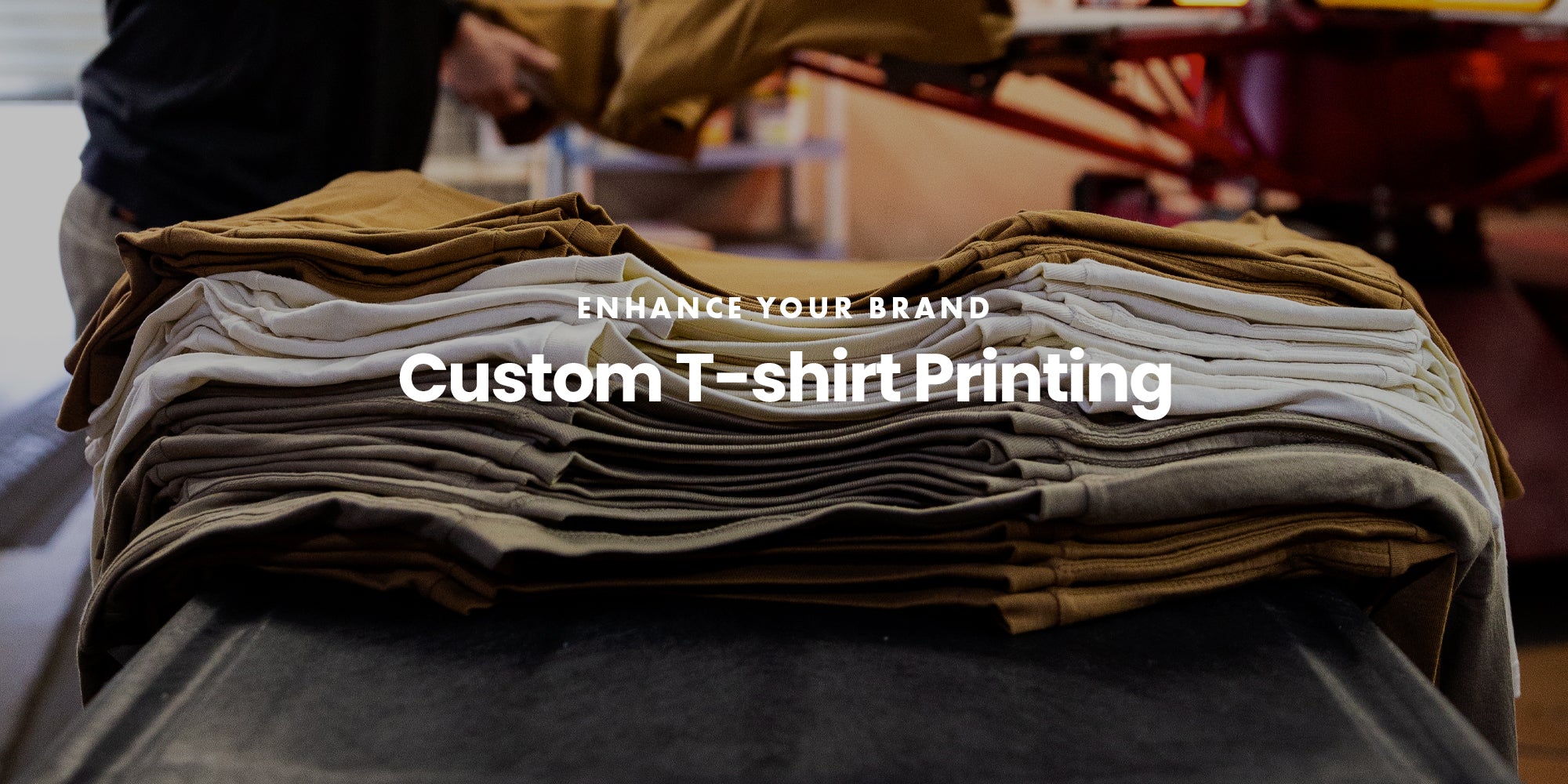Budget-Friendly T-Shirt Printing for Startups
Budget-Friendly T-Shirt Printing for Startups
Blog Article
Screen Printing Uncovered: Everything You Need to Know Concerning Tee Shirt and Garment Printing Strategies
If you've ever before asked yourself how those dynamic styles end up on your favored tee shirts, you remain in the ideal area. Display printing is a remarkable method that integrates art with technique, providing limitless opportunities for creative thinking. Comprehending the basics, from tools to ink choices, can substantially influence your results. Ready to check out the vital elements that make screen printing an art form? Let's discover the information that can raise your projects.
The Essentials of Screen Printing: How It Works
When you plunge right into display printing, you'll discover it's both an art and a science. At its core, display printing includes producing a stencil, or display, that allows ink to pass via only in certain locations.
Following, you'll mix your inks and prepare your printing surface. Setting the display over the fabric, then make use of a squeegee to push ink with the screen onto the garment. This procedure requires precision, as you desire clear, vibrant prints. After printing, you'll heal the ink with warmth, ensuring it adheres to the fabric and lasts with washes. Each step is vital, and grasping them will certainly raise your display printing abilities, transforming straightforward garments into special, meaningful items.
Kinds Of Screen Printing Strategies
Once you realize the fundamentals of screen printing, it's time to explore the different strategies that can raise your layouts. One preferred approach is conventional screen printing, where ink is pressed through a stenciled display.
If you're aiming for fine details, take into consideration discharge printing. This method eliminates color from the material, leaving a soft, classic look. An additional option is plastisol printing, known for its toughness and dazzling shades, making it a favorite for many brand names. Experiment with halftone printing to produce gradient effects and elaborate designs. Each technique has its distinct beauty, so don't be reluctant to attempt them bent on locate what fits your style best!
Crucial Tools for Display Printing
To attain spectacular outcomes in display printing, having the ideal tools is fundamental. You'll need a durable screen printing frame, which holds the mesh that transfers your style onto the garment. Next off, spend in top quality mops; these are essential for using ink equally across the screen.
Selecting the Right Inks and Products
When choosing inks and products for display printing, you need to take into consideration the kind of ink that functions ideal for your job. Think about textile compatibility to guarantee your layouts look last and great long. Discover eco-friendly ink alternatives to make your printing process more sustainable.
Types of Display Inks
Selecting the best screen ink is essential for achieving vibrant, resilient prints that fulfill your task's requirements. There are several kinds of screen inks to examine. Specialty inks, such as metallic or glow-in-the-dark, can include one-of-a-kind effects to your designs.

Fabric Compatibility Factors To Consider
Understanding textile compatibility is vital for achieving high-grade screen prints, specifically since different materials respond distinctly to numerous inks. When picking inks, think about the textile type-- cotton, polyester, or blends. For cotton, water-based inks function well, supplying soft qualities and breathability. Polyester, on the various other hand, usually calls for plastisol inks for much better adhesion and vivid shades. If you're publishing on blends, you could require to make use of a combination of both types. Constantly examine your inks on sample fabric to ensure they adhere appropriately and maintain shade stability. In addition, remember that textile weight and appearance can affect the final end result, so selecting the best ink and material combination is essential for your project's success.
Eco-Friendly Ink Options
Environment-friendly inks are coming to be a prominent selection for screen printers that want to minimize their ecological influence while keeping quality. When choosing inks, take into consideration water-based inks, which are much less harmful and much easier to clean up contrasted to standard solvents. These inks bond well with fabrics, providing dynamic outcomes without toxic chemicals. You may likewise check out eco-solvent inks that use fewer unstable organic substances (VOCs), making them a much safer alternative for both your health and the world.
Furthermore, try to find inks made from renewable energies, such as soy or vegetable-based choices. By selecting the ideal inks and products, you'll not only produce sensational styles but also add to an extra sustainable printing process. Make the button, and your prints will certainly reflect your commitment to the setting!
Preparing Your Design for Screen Printing

Submit Format Demands
To ensure your style looks dynamic and sharp on material, you'll require to pay close attention to file style demands for display printing. Make sure your you can try here layout has a transparent history to avoid undesirable white edges on your prints. Keep color settings in mind; CMYK is common for display printing, so convert your RGB creates appropriately.
Shade Splitting Up Strategies
Color separation is a necessary action in preparing your layout for display printing, and mastering it can substantially boost your print top quality. You'll need to break your style right into individual colors, as each color needs a different display during printing. Start by identifying all the colors in your design and produce layers for each one. You can utilize software like Adobe Photoshop or Illustrator to isolate and separate shades properly. Be particular to conserve each layer as a separate documents, usually in a style like TIFF or PSD. This accuracy not just assures exact shade representation however additionally improves the printing process. By paying focus to color splitting up, you'll achieve professional and lively outcomes in your screen-printed garments.
Resolution and Size
Attaining the most effective results in display printing starts with assuring your style has the ideal resolution and dimension. Ideally, your artwork ought to go to the very least 300 DPI (dots per inch) for sharp, clear prints. If you make use of lower resolution, your end product could look pixelated and less than professional.
When it comes to size, take into consideration the measurements of your print area. Layout your art work to match the last print size, ideally producing it in the real dimensions you'll be publishing. This way, you'll prevent any kind of unanticipated scaling problems.
Constantly inspect your design in both vector and raster styles. Vector graphics can be scaled without shedding high quality, making them optimal for display printing. Preparing properly will ensure your style looks impressive on every garment!
Step-by-Step Screen Printing Refine
Screen printing is a dynamic process that allows you to create dynamic layouts on different surface areas. To obtain begun, you'll require a screen, emulsion, and your selected ink.
Pour ink onto the display and utilize a squeegee to push the ink with the stencil onto the textile. Lift the display very carefully and allow the print completely dry. You have actually successfully display published your design.
Tips for Successful Display Printing Projects
While you're diving right into your screen printing jobs, keep in mind that prep work is vital to success. Beginning by collecting all your products-- inks, garments, squeegees, and screens. A tidy work space helps stop undesirable mistakes, so tidy up prior to you start.
Following, verify your art work is high-resolution and correctly sized for your garment. Evaluate your display for correct exposure and tidy it completely to stay clear of smudges. When blending your inks, comply with the producer's standards to accomplish the right uniformity.
Throughout printing, use also stress with your squeegee for constant results. Don't rush; take your time to verify each print fulfills your requirements. After printing, allow your garments completely dry totally before handling or packaging them.
Lastly, constantly maintain an example of your help future recommendation. This method, you find out here can examine your progression and improve your strategies with time. Pleased printing!

Often Asked Concerns
For how long Does It Require To Establish a Screen Printing Job?
Establishing a screen printing task generally takes about thirty minutes to an hour. You'll prepare the displays, mix inks, and readjust the press. The moment varies based on intricacy and experience, so remain arranged!
Can I Print on Different Fabric Enters Using the Very Same Strategy?
Yes, you can print on various textile kinds using the very same technique, yet you'll need to change your settings and inks. Some fabrics absorb ink in a different way, so experimenting assurances the best results for each product.
What Are Common Blunders to Avoid in Display Printing?
When screen printing, stay clear of common mistakes like making use of the incorrect ink, overlooking proper direct exposure times, or avoiding pre-press checks. Constantly evaluate your setup and preserve clean displays to ensure high quality results each time.
Exactly How Can I Appropriately Clean and Keep My Screen Printing Devices?
To effectively clean and maintain your display printing equipment, you must routinely clean screens with suitable solvents, examine squeegees for wear, and assure all devices are stored dry and dust-free. Uniformity stops pricey repairs and boosts performance.
Is Screen Printing Eco-friendly Contrasted to Other Techniques?
Screen printing can be much more eco-friendly than various other techniques, especially if you use eco-conscious products and water-based get more inks. By selecting lasting materials and techniques, you decrease waste and decrease your effect on the planet.
Display Printing Uncovered: Everything You Required to Know About T-Shirt and Garment Printing Strategies
At its core, display printing includes creating a pattern, or screen, that enables ink to pass through only in details areas. Position the screen over the material, after that utilize a squeegee to push ink through the display onto the garment. One prominent technique is standard screen printing, where ink is pushed with a stenciled screen.When selecting inks and products for display printing, you need to take right into account the kind of ink that works best for your project.
Report this page